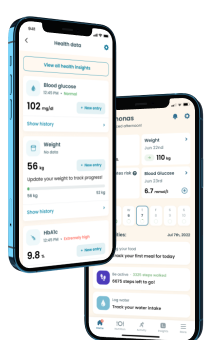How To Manage Type 2 Diabetes With Diet and Exercise
Can exercise help control diabetes? The answer is yes. Exercise promotes weight loss, which can help to make type 2 diabetes more manageable.

Can exercise help control diabetes? The answer is yes. Exercise promotes weight loss, which can help to make type 2 diabetes more manageable.
How strongly does exercise affect weight loss? And what are the additional benefits you can experience from physical activity?
Let’s dive in.
How Does Exercise Help Manage Diabetes?
In a study consisting of a randomized controlled trial, type 2 diabetes patients received a one-year intensive lifestyle intervention program consisting of a low-calorie diet combined with physical exercise. Patients in the control group received standard diabetes care based on clinical guidelines.
Results showed that 61% of patients that underwent the lifestyle intervention program experienced full remission from type 2 diabetes, compared to only 12% in the control group.
It’s worth noting that these results don’t suggest a direct correlation between exercise and reversion of type 2 diabetes, but rather a correlation between weight loss and reversion. So while exercise doesn’t directly cause remission, it is considered a factor that promotes weight loss and, in turn, allows for remission.
Why is it so? Because type 2 diabetes occurs due to too much fat in the pancreas and liver in combination with susceptibility to fat-induced damage. This causes the body to stop producing insulin. Weight loss allows organs to function properly again and insulin action to return to normal.
When it comes to type 1 diabetes, no studies currently suggest that weight loss can cause remission. That’s because this kind of diabetes happens when the immune system destroys insulin-producing cells, so the cause is not directly related to body weight.
However, exercising and weight loss are still important because research shows that they provide a wide range of benefits.
We’ll discuss these in more detail later, but for now, the question is – do diabetic patients need to exercise for weight loss? Or does a healthy diet suffice?
How Exercise Affects Weight Loss
It is theoretically possible to lose weight without exercising. Weight loss depends on a caloric deficit, which can be achieved with a low-calorie diet.
However, studies show that the combination of diet and exercise can speed up the process significantly. It can also make it easier to stick to a weight loss program because combining diet with exercise allows you to eat more calories (since you’re burning more calories during the day). This makes adherence to a low-calorie diet easier.
Apart from these benefits, lifestyle interventions that include exercise can help you manage symptoms of diabetes, reduce the risk of complications, and improve your quality of life. Let’s explore how.
How Exercise Improves Blood Glucose
For starters, exercise allows you to manage diabetes by promoting blood glucose control.
According to the American Diabetes Association, patients with type 1 diabetes can use exercise to improve their glycemic control. For this purpose, it is particularly recommended to perform mixed activities such as field sports and interval training, as these exercise types display the best effect on blood sugar stability.
If you wish to perform aerobic exercise instead, it’s important to do so in postprandial periods and with the inclusion of an insulin dose in the meal before exercise.
For patients with type 2 diabetes, the recommendation is to perform a combined training of aerobic activity and resistance exercise training because it has been proven to have a superior effect on glycemic control.
Additional Health Benefits of Exercise

Physical activity can have profound effects on various aspects of your health.
In general, research shows that exercise improves brain health, strengthens bones and muscles, prevents premature death, and lowers the risk of developing various diseases – including heart disease and some types of cancer.
Other benefits include lower risk of nerve damage, blood pressure control, lowering “bad” cholesterol and raising “good” cholesterol, and better sleep. Exercise can also be helpful in managing digestive and kidney diseases.
On a mental level, exercise also improves self-esteem and reduces negative moods, anxiety, and depression. This can be helpful for people with diabetes, who are at high risk of developing mental health problems.
Finally, a resistance training exercise program allows you to build muscle mass. This in turn improves balance, reduces stress levels, improves energy levels, enhances immune system functioning, and improves insulin sensitivity.



It’s also worth mentioning that exercise can sharply lower the risk of developing type 2 diabetes if you have prediabetes or you’re experiencing symptoms of insulin resistance. Therefore, it’s a good addition to a diabetes prevention program.
Exercise Guidelines for People With Diabetes
Exercise can affect your blood glucose levels and worsen some conditions associated with diabetes, so it’s important to seek medical help before implementing changes to your physical activity.
Generally, here are some guidelines that you should follow:
- Check your blood glucose level before exercising (your doctor will tell you the normal range) and after exercising
- Drink plenty of fluids before exercising because working out causes water loss, and this may interfere with your blood glucose
- Carry a snack that contains 15g of fast-acting carbohydrates in case your blood glucose drops
- Pay special attention to your blood glucose if the temperature is too high or too low, as insulin action changes under extreme temperatures
- Carry your medical ID
How Much Should You Exercise?
It is recommended for all adults to dedicate 150 minutes per week to moderate-intensity exercises such as brisk walking or 75 minutes of rigorous exercise such as running.
As for resistance training, the recommendation is to perform muscle-building exercises at least two days per week.
How to Stick to an Exercise Regimen

Building healthy habits can be challenging, especially if the habits involve physical or mental effort.
To ensure you remain committed to your exercise regimen, try these tips:
Start Small
Incorporating different habits incrementally is a great way to improve adherence. It’s much easier to begin with two days of moderate-intensity activity per week rather than diving right into a full-scale routine. Once your body adapts to physical activity, you can gradually increase your activity level until it reaches an ideal target.
Focus On Sustainability
The most effective way to ensure long-term success for an exercise routine is to make it enjoyable. To achieve this, it’s important to assess which physical activities bring you pleasure. Let’s say you’re trying to choose a form of aerobic training. Perhaps you don’t like running, but you’re interested in taking Tai Chi classes at your local gym.
It’s equally important to choose activities that fit into your daily routine. For example, if getting to the gym is too hard or inconvenient for you, you can choose to purchase free weights like dumbbells to perform your strength training at home or even perform bodyweight exercises. Another tip is to find opportunities to exercise naturally throughout the day. This includes walking rather than driving when possible.
It’s also advisable to start with moderate exercise before performing intense forms of physical activity, as this ensures commitment and, in turn, sustainability.
Remember Your “Why”
Performing an action becomes easier once you remember the benefits of doing it. Always remind yourself of the health improvements you’re seeking through exercise. This will keep you encouraged on days when you feel demotivated.
The great thing about exercise is that it has so many benefits that you’ll easily find a “why” to focus on. Here are some examples:
- Improve my cognitive health and job performance
- Reduce my risk of chronic disease, high blood pressure, and cardiovascular disease
- Reduce negative emotions and anxiety
- Allow me to live longer and healthier
- Allow me to wake up in the morning feeling more energetic
- Overall, help me achieve optimal health by eliminating health issues
You can also rely on motivators specific to lower body weight, such as increased confidence and diabetes-specific benefits.
Track Your Progress
Tracking your progress on an exercise journal or an app like Klinio can help you remain accountable for your new routine. It helps you visualize your progress, both in terms of adherence and weight loss, which in turn boosts motivation to continue.
Progress tracking also offers an additional benefit: it allows you to notice trends in your routine. If, after looking at your exercise logs, you realize that you tend to skip weight training on Wednesdays, this may point out that it could be suitable to adjust the time of your workout or the activity itself so that it becomes easier to adhere to.
Reward Yourself
Both short-term and long-term rewards are a highly effective way to increase motivation because they make the activity itself feel rewarding.
Moreover, it’s always good to honor your achievements. Implementing healthier habits takes time and perseverance. Acknowledging the progress you’ve made is an important part of self-appreciation.
There are many kinds of rewards you can give yourself. The best option depends on your personal preferences and what gives you the most pleasure.
Ready to Get Started?
Given everything we’ve covered about physical activity and diabetes, you may be looking forward to starting a new exercise routine.
If so, check out the Klinio app – it allows you to track your progress in aspects such as weight loss and blood glucose. It also provides hundreds of no-equipment beginner workouts you can do at home.
Take a quiz and get your diabetes-management plan today!









